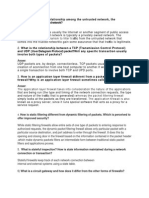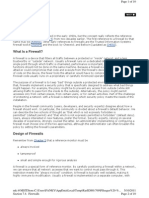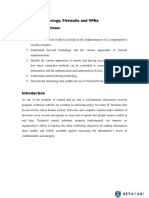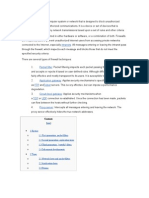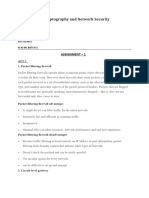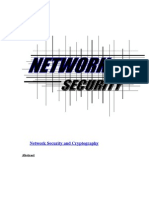Enterprise Firewall Types: National Security Agency
Enterprise Firewall Types: National Security Agency
Uploaded by
Felipe Ramirez HerreraCopyright:
Available Formats
Enterprise Firewall Types: National Security Agency
Enterprise Firewall Types: National Security Agency
Uploaded by
Felipe Ramirez HerreraOriginal Title
Copyright
Available Formats
Share this document
Did you find this document useful?
Is this content inappropriate?
Copyright:
Available Formats
Enterprise Firewall Types: National Security Agency
Enterprise Firewall Types: National Security Agency
Uploaded by
Felipe Ramirez HerreraCopyright:
Available Formats
NATIONAL SECURITY AGENCY
Enterprise Firewall Types
Enterprise firewalls are placed on the perimeter of a network to enforce a security policy by allowing or denying certain network traffic. The three types of enterprise firewalls (ordered by increasing complexity) are: 1) Packet Filtering 2) Stateful Packet Filtering 3) Application Proxies Packet Filtering A packet filter only examines traffic based on the packet header. The header includes such fields as the source and destination IP addresses, the source and destination ports, and the network protocol used. Packet filtering is usually employed on perimeter routers in the form of access control lists (ACLs) and is very fast and effective. It can be tedious to configure since rules must be defined for each protocol, range of addresses, and direction of flow. For example, consider the case where host A wants to talk to host B on TCP port 23. Both the desired rule and its reciprocal rule must be entered into the ACL: Stateful Packet Filtering Like packet filtering, a stateful packet filter works at the network and transport layers (on the OSI model) by examining the packet header. Unlike packet filtering, if the flow is allowed, a stateful packet filter keeps track of information about the connection's state and enters it into a state table. Entries include source and destination IP addresses, the firewall's network interfaces, source and destination ports, protocol, ACK and SEQ numbers, etc.
This concept of state allows the rules to be more concise than in packet filtering since reciprocating rules are systematically inferred and not manually entered. System performance is increased because packets entering the firewall are first compared to the state table, not to the ACL. If a packet is part of an established connection, then it is allowed. If the packet cannot be associated with an established connection, then a complete check against the ACL rules is performed.
I73-001-06
Many stateful packet filters can alter banner information to obfuscate a server that is being protected. Some stateful packet filters have the ability to look into the application layer data and make additional filtering decisions. An example of this is to allow HTTP GET messages but not HTTP POST messages. Stateful packet filters are limited in their protocol knowledge and lack the ability to filter on encrypted traffic. Examples of stateful packet filters include the Cisco PIX and the NetScreen firewalls. Application Proxies An application proxy is the most sophisticated firewall type. In addition to the features of both packet filters and stateful packet filters, application proxies contain both a server and a client process for each protocol they support. They will establish two completely separate sessions: one from the client to firewall, and another from the firewall to server. In this way, they establish a proxy that inspects and rewrites all packets for that protocol, preventing direct contact between the client and server. Since the connection is proxied through the firewall, another advantage is the ability to read encrypted sessions. In theory, the proxy will have a complete understanding of how the protocol functions and be able to enforce compliance to established standards. For protocols where a proxy does not exist, a generic proxy can be created that allows a protocol to traverse the firewall. Although these generic proxies don't offer as much protection as an applicationaware proxy, they do have the capability for robust logging.
In comparison to packet filters and stateful packet filters, application proxy performance is slower due to the complexity of filtering through all the application data. They are also more susceptible to overflow attacks because they are more complex and have a larger code base.
Conclusion The line between stateful packet filters and application proxies is beginning to fade, while pure packet filtering has predominantly moved to the perimeter router. The best type of firewall is the one that gives a balance of security and functionality appropriate to established security policy. No firewall will keep the network 100% safe; do not depend on one device to secure a network. Adopt a "defense in depth" strategy: deploy multiple defense mechanisms between adversaries and their targets including both protection and detection methods.
You might also like
- Chapter 6 Review AnswersDocument2 pagesChapter 6 Review Answerspufucuddlypuffs100% (3)
- Trusted Systems, Firewalls, Intrusion Detection SystemsDocument18 pagesTrusted Systems, Firewalls, Intrusion Detection SystemsMukesh100% (34)
- Firewalls: General Principles & Configuration (In Linux)Document34 pagesFirewalls: General Principles & Configuration (In Linux)XozanNo ratings yet
- Case Study On "Firewall"Document8 pagesCase Study On "Firewall"Lokesh ShindeNo ratings yet
- Firewalls in Network Security: Firewall Categorization MethodsDocument7 pagesFirewalls in Network Security: Firewall Categorization Methodsmustafa albayatiNo ratings yet
- CS PPT-3Document27 pagesCS PPT-3lalar80000No ratings yet
- CS CH 3Document27 pagesCS CH 3udayrangpariya2003No ratings yet
- Firewall Design Principles: Software Engineering 4C03Document8 pagesFirewall Design Principles: Software Engineering 4C03Ramachandran1707No ratings yet
- Unit VDocument53 pagesUnit Vjayaraj2024No ratings yet
- Firewall 86 SlidesDocument86 pagesFirewall 86 SlidesHarneet Singh ChuggaNo ratings yet
- 83 10 41 PDFDocument7 pages83 10 41 PDFPhillipNo ratings yet
- An Introduction To Firewalls and The Firewall Selection ProcessDocument10 pagesAn Introduction To Firewalls and The Firewall Selection ProcessS SagarNo ratings yet
- Firewall AbstractDocument5 pagesFirewall AbstractJijo JamesNo ratings yet
- Network Security Using FirewallsDocument11 pagesNetwork Security Using Firewallsashok_jinkala31100% (2)
- Unit-2: Network Defense ToolsDocument24 pagesUnit-2: Network Defense ToolsSandip MouryaNo ratings yet
- AnswerDocument5 pagesAnswerVIKRAM KUMARNo ratings yet
- HCSCA102 HCNA-Security-CBSN Chapter 2 Basic Firewall Technologies V2.5Document73 pagesHCSCA102 HCNA-Security-CBSN Chapter 2 Basic Firewall Technologies V2.5Jorge medinaNo ratings yet
- Network (In) Security Through IP Packet FilteringDocument14 pagesNetwork (In) Security Through IP Packet FilteringSalman HabibNo ratings yet
- Firewall: Name: Sumit Sharma Register no.:RA1611003010777Document9 pagesFirewall: Name: Sumit Sharma Register no.:RA1611003010777Sumit SharmaNo ratings yet
- Internet Security Case Study On: Chandrabhan Sharma CollegeDocument11 pagesInternet Security Case Study On: Chandrabhan Sharma CollegeMaaz RaineNo ratings yet
- CS PPT-3Document32 pagesCS PPT-3noreply.myworkspaceNo ratings yet
- Firewall AbstractDocument5 pagesFirewall AbstractSanthoshNo ratings yet
- Protecting Information Systems With Firewalls: Revised Guidelines On Firewall Technologies and PoliciesDocument7 pagesProtecting Information Systems With Firewalls: Revised Guidelines On Firewall Technologies and PoliciesBrkNo ratings yet
- MK @MSITStore C Users PANKY AppData Local Temp Rar$DI00.700 PFDocument10 pagesMK @MSITStore C Users PANKY AppData Local Temp Rar$DI00.700 PFpankulgNo ratings yet
- Electronics Communication - Engineering - Information Network Security - Security Technologies Firewalls and Vpns - NotesDocument54 pagesElectronics Communication - Engineering - Information Network Security - Security Technologies Firewalls and Vpns - NotesmuditambimukhatshelwandouNo ratings yet
- What Is FirewallDocument4 pagesWhat Is Firewallahmedtehseem0062No ratings yet
- FireDocument61 pagesFireAnuj SinghNo ratings yet
- Last To Handle Outgoing Traffic.: Packet Filtering Circuit Relay Application Level GatewayDocument4 pagesLast To Handle Outgoing Traffic.: Packet Filtering Circuit Relay Application Level GatewayJaideep SinghNo ratings yet
- Network Security Assignment 1Document5 pagesNetwork Security Assignment 1Ataneta MotuNo ratings yet
- Firewalls and Network Security: Presented byDocument12 pagesFirewalls and Network Security: Presented byapi-19799369No ratings yet
- Short Note On-Firewall, Types of Firewall, - Packet FilteringDocument8 pagesShort Note On-Firewall, Types of Firewall, - Packet Filteringsurajmk123No ratings yet
- Who Many Types of FirewallDocument2 pagesWho Many Types of FirewallMohammed SuhelNo ratings yet
- NIS Unit 4Document13 pagesNIS Unit 4manthanjagatkar998No ratings yet
- Network Security: Lecturer: Guled Yusuf MihileDocument38 pagesNetwork Security: Lecturer: Guled Yusuf MihileOsmanicNo ratings yet
- Firewalls Are Used To Protect Both Home and Corporate NetworksDocument4 pagesFirewalls Are Used To Protect Both Home and Corporate NetworksAnkita SoniNo ratings yet
- Firewall: By: Amit Mahajan Btech 7 SemDocument20 pagesFirewall: By: Amit Mahajan Btech 7 Semamit mahajan100% (1)
- IntranetsDocument6 pagesIntranetsSowbarnika Sampath KumarNo ratings yet
- Assignment - 1 Cryptography R177219017Document9 pagesAssignment - 1 Cryptography R177219017singhal9549akashNo ratings yet
- Guidelines in Firewalls and Firewall Policies: Recommendation of The National Institute of Standards and Technology Released On 2009Document5 pagesGuidelines in Firewalls and Firewall Policies: Recommendation of The National Institute of Standards and Technology Released On 2009mo3awia2099No ratings yet
- Firewall (Computing) : Ubuntu GufwDocument6 pagesFirewall (Computing) : Ubuntu GufwKarthik RamanNo ratings yet
- Firewalls: Security TechnologiesDocument63 pagesFirewalls: Security TechnologiespiyushNo ratings yet
- A Firewall Is A Set of Related ProgramsDocument11 pagesA Firewall Is A Set of Related ProgramsDeep RandhawaNo ratings yet
- Chapter6 Review Question&ExercisesDocument6 pagesChapter6 Review Question&ExercisesZenric Jr ClareteNo ratings yet
- Hashing Functions PropertiesDocument9 pagesHashing Functions PropertiesRashmi vbNo ratings yet
- Firewall and TypesDocument6 pagesFirewall and TypesJeremy KipgenNo ratings yet
- FirewallDocument8 pagesFirewallRamesh SharmaNo ratings yet
- Firewalls: Vivek SrinivasanDocument17 pagesFirewalls: Vivek SrinivasanXozanNo ratings yet
- Charles WorkDocument12 pagesCharles Workcharles mmariNo ratings yet
- Firewall & It's Types: Arslan Kamran SE6 Muneeb Ahmed CS6 Mehmood-ul-Hassan CS 6Document10 pagesFirewall & It's Types: Arslan Kamran SE6 Muneeb Ahmed CS6 Mehmood-ul-Hassan CS 6Arslan Kamran JuttNo ratings yet
- FIREWALLSDocument10 pagesFIREWALLSriaz ahamedNo ratings yet
- FirewallDocument63 pagesFirewallLorie Jane ReyesNo ratings yet
- CC FirewallsApplicationProxyGatewayARCDocument3 pagesCC FirewallsApplicationProxyGatewayARCshahedctgNo ratings yet
- Unit 7 & 8 Info Sec ControlsDocument28 pagesUnit 7 & 8 Info Sec ControlsGideon AgbavorNo ratings yet
- Secure Wireless Firewall Integration: Role of The FirewallDocument54 pagesSecure Wireless Firewall Integration: Role of The FirewallFlavio MirandaNo ratings yet
- 5 SecurityDocument38 pages5 SecurityHiwot TadesseNo ratings yet
- Firewall & It's TypesDocument10 pagesFirewall & It's TypesArslan Kamran JuttNo ratings yet
- What Is A FirewallDocument6 pagesWhat Is A Firewall42z4bnwc4nNo ratings yet
- Abstract On Network Security and CryptographyDocument13 pagesAbstract On Network Security and Cryptographytharun89% (9)
- Cap9 Access Control ListsDocument87 pagesCap9 Access Control ListsDobre DanielNo ratings yet
